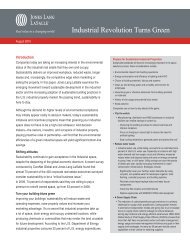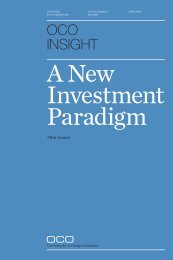PDF: 21st Annual Corporate Survey Complete Results - Area ...
PDF: 21st Annual Corporate Survey Complete Results - Area ...
PDF: 21st Annual Corporate Survey Complete Results - Area ...
Create successful ePaper yourself
Turn your PDF publications into a flip-book with our unique Google optimized e-Paper software.
21 st <strong>Annual</strong><br />
porate Analysis of the 2006 <strong>Corporate</strong> <strong>Survey</strong><br />
By Phil Schneider, Partner,<br />
Deloitte Consulting, Practice Lead for Global<br />
Expansion Optimization (GEO)<br />
First, I see that 83 percent of the respondents are in manufacturing,<br />
more than half of the respondents have two<br />
or fewer domestic facilities (though nearly 60 percent of<br />
the respondents have five or more foreign facilities), and only<br />
25 percent of them have actually put in a new location in the<br />
last year — this will naturally skew the answers and affect the<br />
ranking in importance of some of the factors.<br />
It’s no surprise to see labor costs as the top factor. It is the<br />
top variable cost for most companies and drives so many projects,<br />
especially those going offshore. With ever-increasing<br />
pressure on manufacturers to lower prices, it is only natural<br />
that they will continue to seek lower labor costs. However, we<br />
do not see this pattern as much in very high-tech or capitalintensive<br />
projects where availability and quality of skills, market<br />
access, and taxes are key drivers.<br />
Incentives are sort of double counted, with both state and<br />
local incentives and tax exemptions listed. Nonetheless, this<br />
tracks with what many clients say but, in the end, we find<br />
other issues are the true drivers and incentives are the differentiators<br />
among closely competitive candidates in the final phases.<br />
Industries where incentives and overall tax rates truly are<br />
the key drivers are those that throw off tremendous profit<br />
and/or have huge capital expenditures, such as bio-pharma<br />
and semiconductors.<br />
I’m surprised that the availability of telecommunications<br />
services and high-speed Internet access were ranked so high, as<br />
these are rather ubiquitous — at least in the Western world.<br />
Telecom is a “must have,” but nearly every location has it so it<br />
is rarely a differentiator or even a factor of consequence in my<br />
experience.<br />
It’s the same with highway accessibility. I agree that it is<br />
critical in the first phases of location screening, but it tends to<br />
act more as a check-off factor to narrow the field to a long list<br />
and isn’t a factor in determining the short-list or final candidates<br />
as so many locations have good to excellent access. We<br />
find that customer access (i.e., time/cost to get product to customers)<br />
is the real driver, and highways are the facilitators<br />
within the defined zone. Those that don’t have the access will,<br />
of course, be eliminated. However, proximity to suppliers/<br />
markets is the highest-rated reason for relocation at 28 percent<br />
versus 20 percent for second-place finisher, labor costs (Figure<br />
23). That tracks with our experience, where those are the<br />
number-one and two issues, in that order.<br />
Availability of skilled labor is, however, a big issue and has<br />
been for a long time. I am surprised it isn’t rated even higher.<br />
It is disheartening to see proximity to technical universities,<br />
training programs, and ratings of public schools ranked relatively<br />
low, as these factors are key in providing skilled manufacturing<br />
and other talent within a market. This has become a serious<br />
Achilles heal for the United States and one that must be<br />
addressed if we have any hope of maintaining our manufacturing<br />
and process prowess.<br />
I strongly suspect energy availability and costs are going to<br />
rise in importance in the next year. Already our clients are<br />
pushing this issue to the front, and it is even driving relocations<br />
for manufacturers escaping areas with rapidly escalating<br />
power costs. Along those lines, I wonder whether railroad service<br />
will gain more importance in the future as fuel costs continue<br />
to rise.<br />
I’m surprised that accessibility to a major airport is ranked so<br />
low, as so many clients put that very high on the list as an<br />
early screen — just like highway accessibility. Often they want<br />
to be within two hours of a medium to large airport, or close<br />
to a smaller one with excellent connections to a large hub. It’s<br />
more of a check-off factor or first-level screen. If the sample<br />
had fewer mid-sized manufacturers and more service<br />
providers and large global manufacturers, I suspect this factor<br />
would rise in importance.<br />
I’m not surprised that right-to-work state continues to<br />
decline in importance; it’s not nearly the issue it was 15–20<br />
years ago.<br />
Finally, I agree that quality-of-life factors such as colleges in<br />
area and recreational and cultural opportunities are low priorities<br />
for mid-scale manufacturers, but they rise in importance<br />
significantly for higher technologies, service operations,<br />
R&D, and headquarters operations.<br />
The location choices offshore track pretty well with what<br />
we are seeing with our clients, i.e., a very heavy Asia focus,<br />
dominated by China, with interest in India on the rise, and<br />
some Southeast Asian countries now competing more strongly<br />
with China, such as Vietnam (and Singapore continues to<br />
do very well with semiconductors and bio-pharma), followed<br />
by Mexico (which has seen an up tick), and Eastern Europe.<br />
We have seen some new interest in the UAE given the relative<br />
safety for the region and very low energy costs, plus government<br />
inducements to attract manufacturing projects.<br />
Notice that the percentage of high-skilled jobs going to<br />
offshore facilities is pretty high (36 percent) — low-skilled is<br />
still higher (48 percent), but high-skilled is definitely increasing<br />
all the time. More and more companies are going offshore<br />
to find these high skills at competitive rates, and this should<br />
really concern us as even our high-skilled base is quickly being<br />
hollowed out.







